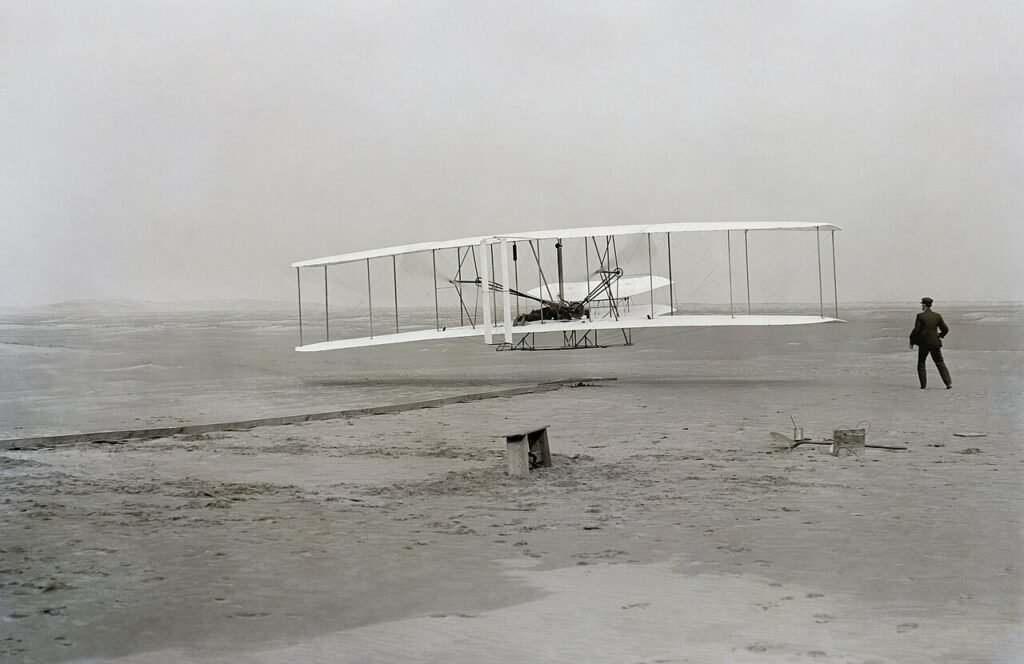For as long as humans have looked up at the skies, the idea of flight has captivated our imagination. From ancient myths of winged beings to today’s sophisticated jetliners crisscrossing continents in hours, aviation has come a long way. This article explores the journey of aviation — from its earliest experiments to the modern marvels that shape our skies.


Source: Wikipedia
Source: Wikipedia
The Earliest Dreams of Flight
Long before the first real aircraft took off, flying was a fantasy. Ancient civilizations told stories of gods and men soaring with wings — from Icarus in Greek mythology to Da Vinci’s flying machines in Renaissance sketches. These early visions, though imaginative, laid the groundwork for what would become a lifelong human pursuit.
18th–19th Century: Balloons and Gliders
The first actual human flights happened not with engines, but with hot air balloons:
- In 1783, the Montgolfier brothers launched the first manned balloon flight in France.
- Later, Sir George Cayley (known as the father of aviation) built the first successful glider capable of carrying a person in the early 1800s.
This era sparked interest in aerodynamics, structure, and control — key principles of modern aircraft design.
1903: The Wright Brothers Take Off
The true birth of powered flight came on December 17, 1903, when Orville and Wilbur Wright flew the Wright Flyer at Kitty Hawk, North Carolina.
- Duration: 12 seconds
- Distance: 120 feet
- Power: A 12-hp engine with wooden propellers
This short flight changed history. The Wright brothers demonstrated not just lift, but controlled, sustained, and powered flight — the key to modern aviation.
1914–1945: War and Innovation
WWI (1914–1918):
Aviation rapidly evolved during World War I. Aircraft were used for reconnaissance, then adapted for combat. This period led to:
- Biplanes with mounted guns
- Better engines and maneuverability
Interwar Period:
Aviation began transitioning into civil use. Airlines like KLM (1919) and Qantas (1920) were founded. Charles Lindbergh’s solo Atlantic crossing (1927) showed that long-range flights were possible.
WWII (1939–1945):
World War II drove massive technological advancements:
- Introduction of radar, metal airframes, pressurized cabins
- First jet aircraft (German Messerschmitt Me 262)
By the end of WWII, aviation had evolved from fabric-covered wood planes to high-speed metal machines.
1945–1970: The Jet Age and Commercial Aviation
The post-war period ushered in the Golden Age of Air Travel:
- Boeing 707 (1958) launched the Jet Age
- Aircraft like DC-8, Caravelle, and Comet made international travel faster and more comfortable
- Airports expanded and air travel became aspirational
Governments and private companies raced to build faster, larger, and more luxurious airliners.
1970–2000: The Jumbo Era and Global Connectivity
- In 1970, Boeing launched the 747 “Jumbo Jet”, revolutionizing air travel with its size and range.
- More wide-bodies followed: DC-10, L-1011, Airbus A300.
- Low-cost airlines emerged in the 1990s (e.g., Southwest, Ryanair), making flying affordable.
- Air traffic control, airport infrastructure, and aviation safety have dramatically improved.
2000–Today: The Modern Aviation Landscape
Today’s aircraft are smarter, quieter, and more efficient:
- Boeing 787 Dreamliner and Airbus A350 use composites for better fuel efficiency.
- A320neo and 737 MAX feature cutting-edge engines and avionics.
- Supersonic revival, urban air mobility (UAM), and electric aircraft are under development.
- Environmental sustainability and passenger experience are top priorities.
COVID-19 tested the industry, but aviation bounced back with resilience and digital innovation.
What Lies Ahead?
Aviation continues to evolve:
- Hydrogen-powered aircraft
- AI-assisted air traffic management
- Autonomous flying taxis
- Revolutionary designs like blended wing bodies and zero-emission aircraft
The dream of flight that began centuries ago is now a global, multi-trillion-dollar industry — connecting people, cultures, and economies like never before.
Final Thoughts
As we take off on this aviation blogging journey, it’s important to appreciate how far we’ve come. From fragile gliders to state-of-the-art jets, every milestone is a story of human ingenuity, engineering marvels, and the eternal desire to fly.
Welcome aboard. The sky is not the limit — it’s just the beginning.
